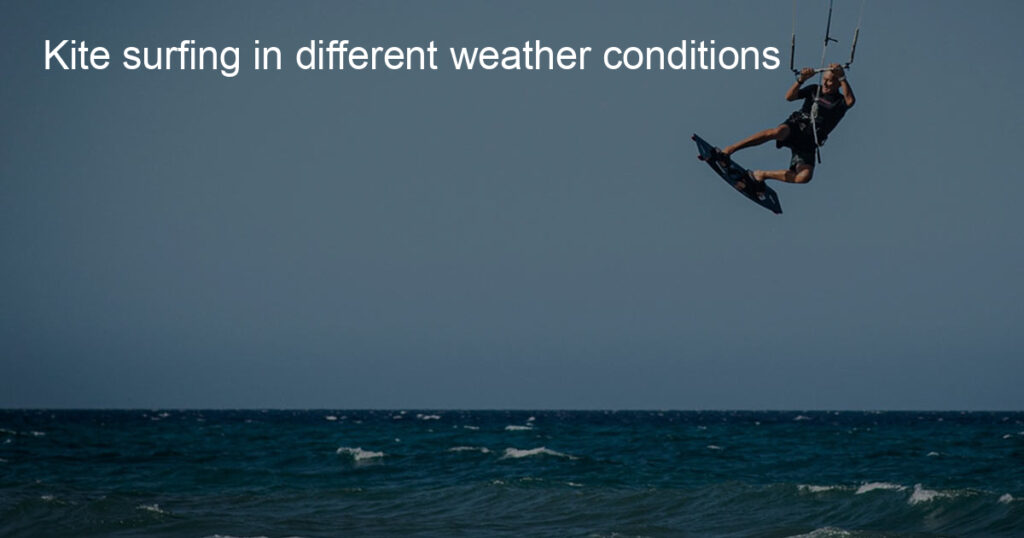Are you wondering if kite surfing is possible in different weather conditions? The answer is yes! Kite surfers can enjoy their sport in a variety of weather conditions, from sunny and warm to cool and windy. Different weather conditions offer different challenges and fun – so get out there and start exploring the possibilities!
What weather is best for kite surfing?
Kite surfing is an exhilarating sport that combines elements from both surfing and kite flying. The key to having the best kitesurfing experience is choosing the right kind of weather for it. For optimal performance, experts recommend light winds with generally good if not flat conditions such as 12-20 knots (13-23mph).
These conditions allow for better control and easier launching, which are essential for a safe and successful kitesurfing experience. A day at the beach with light breezes, plenty of sun,s and warm water can be perfect!
Just remember to stay aware of wind shifts and direction when you’re out there – they can be sneaky sometimes and might turn your perfect session into a challenge.
Can you kite surf in the low wind?
Kite surfing may seem like a sport only possible with strong, gusty winds – and usually, that’s true. However, even in low winds, the avid kite surfer can still get a rush from the waves.
Utilizing the power of the waves themselves, surfers maneuver their boards up against them which produces an updraft to boost them forward. With some practice and a lot of sheer willpower, it is possible to kite surf in low wind conditions – just don’t expect to break any speed records while doing so!
Can you kite surf in the rain?
In theory, you can still kite surf in the rain—there’s no meteorological reason why it would be unsafe. However, all seasoned kite surfers know that wind speeds and water conditions can be so unpredictable when precipitation is involved, making a successful (and safe) session almost impossible.
Furthermore, kites manufactured for kiting in drier climates may not fare as well against wetter weather. So, when it’s raining outside, it may be best to trade that surf session for an indoor hobby like playing board games with family and friends!
Can you kite surf during a thunderstorm?
Kite surfing during a thunderstorm is something few people would dare attempt. While being propelled across the water by wind often leads to an adrenaline-pumping ride, it also comes with a serious level of risk. Even experienced kite surfers should think twice before heading out in the middle of a storm.
The combination of strong winds and potential lightning strikes makes this one activity that isn’t worth risking your safety. So while you might be able to kite surf during a thunderstorm, it is probably wise to keep your board ashore until the storm has passed and conditions are much safer.
What time of day is best for kite surfing?
If you’re looking for the ideal time to get out and go kite surfing, the early morning is when you should look no further. Just after sunrise, when there is a light breeze, is the perfect moment to take the plunge. This time of day provides enough wind for kite surfers of all skill levels and an environment that’s still relatively untouched by other surfers.
The water reflects a peacefulness as the sun begins to set over the horizon, providing an unbeatable experience that doesn’t demand too much from your body even if you decide to stay out until sunset. Furthermore, it’s worth noting that kite surfing earlier in the day means less of a chance of encountering rougher waves as well as less exhaustion in terms of physical strength and energy expenditure.
All in all, there truly is no better way to start your day than with some invigorating kite surfing!
What wind speed is good for kite surfing?
Kite surfing is a thrilling sport, made even more enjoyable with the right wind conditions. Many kite surfers find that wind speeds of around 13-20 knots offer the best balance between allowing them to stay afloat and being able to properly maneuver their kites. For beginners, they may want to assess the winds at 8-13 knots, as these are better suited for smaller and more shallow waters.
Those who are experienced enough should go for gusts of up to 40 knots during their next session! No matter what your skill level may be, make sure you understand the wind speed needed before embarking on your kite surfing adventure.
In conclusion: Kite surfing in different weather conditions
In conclusion, kite surfing is a thrilling experience that every enthusiast should try. The weather will have an effect on your kite surfing journey but with the right know-how and proper preparation, you can enjoy this activity in all kinds of weather conditions. Keep an eye on winds, currents, and tides for optimum safety, as well as get your equipment checked and serviced regularly to ensure maximum success.
Kite surfing allows for a thrilling and unforgettable experience; if you’re prepared for the changing weather then you’ll be able to enjoy this sport any time of year! So, make sure to carry out thorough research on the best times and places to go kite surfing and always be careful while tackling this exciting activity.








